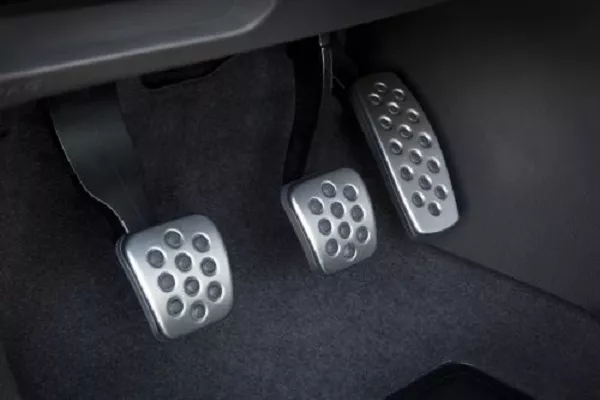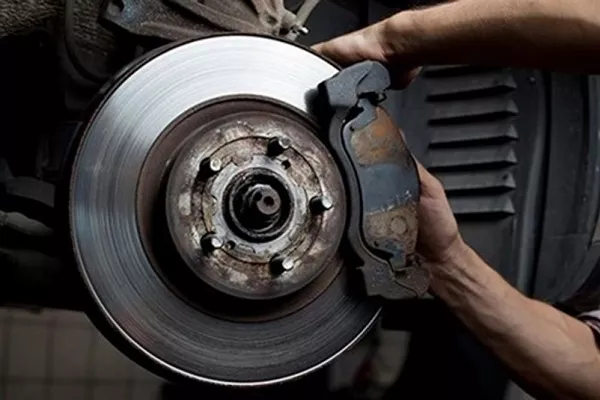Car braking system is a very important component of the vehicle, especially cars. Therefore, if the brake system is not safe, it may lead to many unfortunate situations, affecting the lives of passengers.
Here Philkotse.com tells you some warning signs when the braking system is having problems. Let's check out!
1. Unusual braking force
When you pull the brake and you notice an abnormal feeling, it can also be a sign that the brake has some malfunctions or the brake calipers get stuck. As a result, the friction on one wheel will be significantly higher than that on the other wheel, leading to the tendency of the car to skew to the side where the caliper is jammed.

Abnormal braking forces may also originate from tires
In addition, abnormal braking forces may also originate from tires that are over-inflated or worn out unevenly, causing some wheel to have a poorer traction to the road. In that case, you should immediately bring your vehicle to a service center.
2. Unstable brake pedals
When you see that the brake sometimes works and sometimes does not, it means that there are some issues, such as oil or air leaks, uneven brake pads, contaminated and dirty brake oil, et cetera. The most dangerous thing is when the brake pads tightly clamp on the brake discs due to the hydraulic system losing its elasticity, causing the brake pedal to not return to the original position. Therefore, whenever the brake pedal feels unstable, immediately bring the vehicle to a service center.
3. Strange sounds
Hearing strange sounds while driving is also a warning sign that the brake system is having trouble. However, sometimes the sound may emanate from other parts, such as a high hiss from the brake pads and the unalignment of the working rotor, which must be quickly corrected.
The screeching sound can also be generated from the brake pads or the rubbing of metal due to worn-out brake pads, which make the metal clippers directly contact with the rotor. As a result, every time you use the brake, the friction between these two metal parts makes you difficult to brake, or even damages the rotor.
4. Feeling of vibration
Feeling the brake pedal vibrating when applying the pedal is also a sign that the braking system has problems. If you press the brake in normal situations and you feel the vibration in the brake pedal, it may be caused by the deformation of the rotor. The rotor's uneven surface is not recognizable by its contact with the brake pads but can only be felt by the vibration of the brake pedal.

The pedal is also a sign that the brake system has problems
5. Unusual feeling of braking
Low braking force may result from the wear of the brake pads or problems with the hydraulic systems, such as leaks of brake fluid or air entering the oil reservoir. To see if there is any liquid leak, place an old piece of cloth or cardboard underneath the car overnight. If liquid leaks, it will "settle" on the cloth or cardboard.
In the case of the brake pedal that feels too hard, there may be a problem with small transmitting parts in the car brakes. It is often due to the irregularity of the rotor or contamination in the brake fluid. You should bring your car to the repair center for better inspection.
6. Worn-out brake pads
Most of the latest models are equipped with disc brakes. The working mechanism is: a hydraulic system filled with brake fluid will act on a pair of clamping pads called calipers, which help them squeeze together on a disk called a rotor. Friction is created between the pads and the rotor and causes the wheel to stop spinning.
After a period of usage, the pads would begin to wear out due to friction. This makes the car brakes work less efficiently and the car will take more time to stop, which means a lower braking efficiency.

Most of the latest models are equipped with disc brakes
You can conduct a check by looking between the spokes of the wheel to detect a shiny metallic rotor. Brake pads are located between the caliper and the rotor. If the brake pads are thinner than 1/4 inch (about 6.35 mm), that means they are no longer safe to use and need replacing.
>>> Read more useful tips and advice on car maintenance at Philkotse.com
Recent posts
- Everything You Need To Know About Brake Fluid Aug 17, 2022
- How to use your car brakes properly Nov 07, 2018
- These 7 habits of car owners are awfully damaging their brakes Mar 17, 2021











